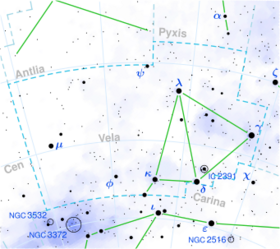Astronomy:HD 74180
| Observation data Equinox J2000.0]] (ICRS) | |
|---|---|
| Constellation | Vela |
| Right ascension | 08h 40m 37.57017s[1] |
| Declination | −46° 38′ 55.4770″[1] |
| Apparent magnitude (V) | 3.81[2] |
| Characteristics | |
| Spectral type | F0Ia[3] |
| U−B color index | +0.34[2] |
| B−V color index | +0.71[2] |
| Variable type | suspected α Cyg[4] |
| Astrometry | |
| Radial velocity (Rv) | −25.3[5] km/s |
| Proper motion (μ) | RA: −6.055[1] mas/yr Dec.: 4.66[1] mas/yr |
| Parallax (π) | 0.68 ± 0.16[1] mas |
| Distance | 990[6] pc |
| Absolute magnitude (MV) | −6.50[6] |
| Details | |
| Mass | 12.63[6] M☉ |
| Radius | Template:Solar radius calculator[6][lower-alpha 1] R☉ |
| Luminosity | 38,000[6] L☉ |
| Surface gravity (log g) | 1.38[6] cgs |
| Temperature | 5,750[6] K |
| Metallicity [Fe/H] | 0.56[7] dex |
| Rotational velocity (v sin i) | 21.7[8] km/s |
| Other designations | |
| Database references | |
| SIMBAD | data |
HD 74180 is a binary star in the constellation Vela. It is approximately 3,200 light years from Earth. The primary component is a yellow-white F-type supergiant with a mean apparent magnitude of +3.81, with a 10th magnitude companion 37.5 arcseconds distant.[9]
b Velorum has been classified as a suspected α Cygni variable star which varies by only 0.06 magnitude. There are possible periods near 53, 80, and 160 days, but the variation is largely irregular.[4] It lies less than a degree from the small open cluster NGC 2645, but is not a member.[6]
Several studies have considered b Velorum to be a highly luminous supergiant or hypergiant with an early F spectral type, for example F2 Ia+,[4] F0 Ia,[10] and F4 I.[11] There were corresponding luminosity estimates of several hundred thousand L☉. A 2015 study used the Barbier-Chalonge-Divan (BCD) system to derive a luminosity of 38,000 L☉ and a cooler less luminous F8 Ib spectral type.[6]
Nomenclature
In Chinese, 天社 (Tiān Shè), meaning Celestial Earth God's Temple, refers to an asterism consisting of Kappa Velorum, Gamma2 Velorum, b Velorum and Delta Velorum.[12] Consequently, Kappa Velorum itself is known as 天社五 (Tiān Shè wǔ), "the Fifth Star of Celestial Earth God's Temple".[13]
References
- ↑ 1.0 1.1 1.2 1.3 1.4 Van Leeuwen, Floor (2007). "Validation of the new Hipparcos reduction". Astronomy & Astrophysics 474 (2): 653–664. doi:10.1051/0004-6361:20078357. Bibcode: 2007A&A...474..653V.
- ↑ 2.0 2.1 2.2 Ducati, J. R. (2002). "VizieR Online Data Catalog: Catalogue of Stellar Photometry in Johnson's 11-color system". CDS/ADC Collection of Electronic Catalogues 2237. Bibcode: 2002yCat.2237....0D.
- ↑ Houk, Nancy (1978). "Michigan catalogue of two-dimensional spectral types for the HD stars". Ann Arbor: Dept. Of Astronomy, University of Michigan 2. Bibcode: 1978mcts.book.....H.
- ↑ 4.0 4.1 4.2 4.3 Van Leeuwen, F.; Van Genderen, A. M.; Zegelaar, I. (1998). "Hipparcos photometry of 24 variable massive stars (α Cygni variables)". Astronomy and Astrophysics Supplement Series 128: 117–129. doi:10.1051/aas:1998129. Bibcode: 1998A&AS..128..117V.
- ↑ Wilson, Ralph Elmer (1953). "General catalogue of stellar radial velocities". Washington. Bibcode: 1953GCRV..C......0W.
- ↑ 6.0 6.1 6.2 6.3 6.4 6.5 6.6 6.7 6.8 Aidelman, Y.; Cidale, L. S.; Zorec, J.; Panei, J. A. (2015). "Open clusters. II. Fundamental parameters of B stars in Collinder 223, Hogg 16, NGC 2645, NGC 3114, and NGC 6025". Astronomy & Astrophysics 577: A45. doi:10.1051/0004-6361/201425085. Bibcode: 2015A&A...577A..45A.
- ↑ Luck, R. Earle (2014). "Parameters and Abundances in Luminous Stars". The Astronomical Journal 147 (6): 137. doi:10.1088/0004-6256/147/6/137. Bibcode: 2014AJ....147..137L.
- ↑ Ammler-von Eiff, Matthias; Reiners, Ansgar (June 2012), "New measurements of rotation and differential rotation in A-F stars: are there two populations of differentially rotating stars?", Astronomy & Astrophysics 542: A116, doi:10.1051/0004-6361/201118724, Bibcode: 2012A&A...542A.116A
- ↑ Mason, B. D. et al. (2014). "The Washington Visual Double Star Catalog". The Astronomical Journal 122 (6): 3466–3471. doi:10.1086/323920. Bibcode: 2001AJ....122.3466M.
- ↑ Humphreys, R. M. (1978). "Studies of luminous stars in nearby galaxies. I. Supergiants and O stars in the Milky Way". Astrophysical Journal 38: 309. doi:10.1086/190559. Bibcode: 1978ApJS...38..309H.
- ↑ Mersch, G.; Heck, A. (1980). "Prediction of spectral classification from photometric observations - Application of the UVBY beta photometry and the MK spectra classification. II - General case". Astronomy and Astrophysics 85: 93. Bibcode: 1980A&A....85...93M.
- ↑ (in Chinese) 中國星座神話, written by 陳久金. Published by 台灣書房出版有限公司, 2005, ISBN:978-986-7332-25-7.
- ↑ (in Chinese) 香港太空館 – 研究資源 – 亮星中英對照表 , Hong Kong Space Museum. Accessed on line November 23, 2010.
- ↑ Radius calculated with temperature and luminosity
 |



